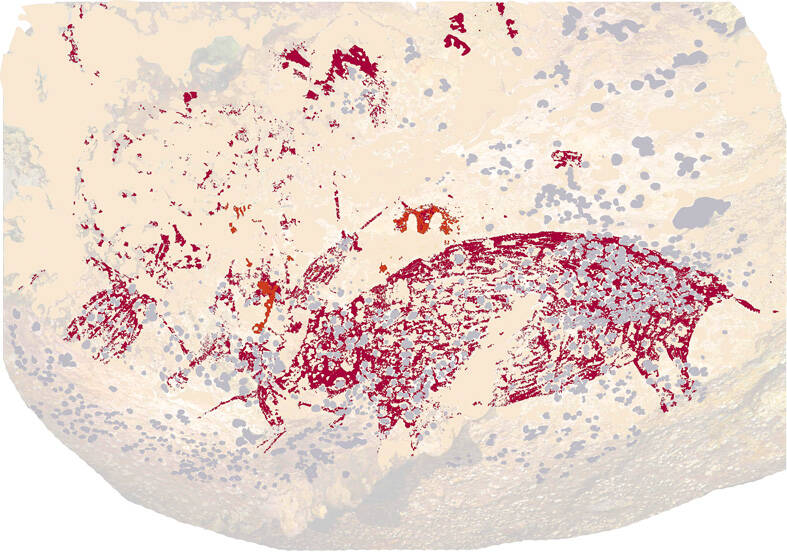On the ceiling of a limestone cave in South Sulawesi, scientists have discovered artwork depicting three human-like figures interacting with a wild pig in what they have determined is the oldest-known confidently dated cave painting — created at least 51,200 years ago.
The researchers used a new scientific approach to determine the minimum age of the newly disclosed painting by using a laser to date a type of crystal called calcium carbonate that formed naturally on top of the painting.
“The method is a significant improvement over other methods and should revolutionize rock art dating worldwide,” said Maxime Aubert, a specialist in archeological science at Griffith University in Australia and one of the leaders of the research published on Wednesday in the journal Nature.

Photo: Griffith University via AFP
The scene, dominated by a representation of a pig measuring 92cm by 38cm that is standing upright along with three smaller human-like figures, is painted in a single shade of dark red pigment. There are other images of pigs in the cave as well.
The researchers interpreted the painting as a narrative scene, which they said would make it the oldest-known evidence of storytelling in art.
“The three human-like figures and the pig figure were clearly not depicted in isolation in separate parts of the rock art panel,” said Griffith University archeologist Adam Brumm, another of the study leaders.
“Rather, the juxtaposition of the figures — how they are positioned in relation to each other — and the manner in which they are interacting were clearly deliberate, and it conveys an unmistakable sense of action. There is something happening between these figures. A story is being told. Obviously, we don’t know what that story was,” Brumm added.
The researchers used the same dating method to reassess the age of another Sulawesi cave painting from a site called “Leang Bulu’ Sipong 4,” also depicting a narrative scene, this time depicting apparent part-human, part-animal figures hunting pigs and dwarf buffalo. It turned out to be at least 48,000 years old.
“We, as humans, define ourselves as a species that tells stories, and these are the oldest evidence of us doing that,” Aubert said.
In the former painting, the interaction between the human-like figures and the pig, a species still inhabiting the island, is somewhat cryptic.
“Two of these figures are holding objects of some kind, and at least one figure seems to be reaching towards the pig’s face. Another figure is positioned directly above the pig’s head in an upside down position,” Brumm said.
Little is known about the people who created the Sulawesi cave paintings.
Aubert said the paintings might turn out to be older than the minimum age determined by the new testing and possibly date to the first Homo sapiens wave to sweep through the region, eventually reaching Australia about 65,000 years ago, on their migration out of Africa.
Until now, the oldest-known cave painting was one at Leang Tedongnge cave, also in Sulawesi, from at least 45,500 years ago.
“This discovery of very old cave art in Indonesia drives home the point that Europe was not the birthplace of cave art, as had long been assumed. It also suggests that storytelling was a much older part of human history, and the history of art in particular, than previously recognized,” Brumm said.
“The earliest Sulawesi rock art is not simple,” Aubert added. “It is quite advanced and shows the mental capacity of people at the time.”

In the sweltering streets of Jakarta, buskers carry towering, hollow puppets and pass around a bucket for donations. Now, they fear becoming outlaws. City authorities said they would crack down on use of the sacred ondel-ondel puppets, which can stand as tall as a truck, and they are drafting legislation to remove what they view as a street nuisance. Performances featuring the puppets — originally used by Jakarta’s Betawi people to ward off evil spirits — would be allowed only at set events. The ban could leave many ondel-ondel buskers in Jakarta jobless. “I am confused and anxious. I fear getting raided or even

Eleven people, including a former minister, were arrested in Serbia on Friday over a train station disaster in which 16 people died. The concrete canopy of the newly renovated station in the northern city of Novi Sad collapsed on Nov. 1, 2024 in a disaster widely blamed on corruption and poor oversight. It sparked a wave of student-led protests and led to the resignation of then-Serbian prime minister Milos Vucevic and the fall of his government. The public prosecutor’s office in Novi Sad opened an investigation into the accident and deaths. In February, the public prosecutor’s office for organized crime opened another probe into

RISING RACISM: A Japanese group called on China to assure safety in the country, while the Chinese embassy in Tokyo urged action against a ‘surge in xenophobia’ A Japanese woman living in China was attacked and injured by a man in a subway station in Suzhou, China, Japanese media said, hours after two Chinese men were seriously injured in violence in Tokyo. The attacks on Thursday raised concern about xenophobic sentiment in China and Japan that have been blamed for assaults in both countries. It was the third attack involving Japanese living in China since last year. In the two previous cases in China, Chinese authorities have insisted they were isolated incidents. Japanese broadcaster NHK did not identify the woman injured in Suzhou by name, but, citing the Japanese

RESTRUCTURE: Myanmar’s military has ended emergency rule and announced plans for elections in December, but critics said the move aims to entrench junta control Myanmar’s military government announced on Thursday that it was ending the state of emergency declared after it seized power in 2021 and would restructure administrative bodies to prepare for the new election at the end of the year. However, the polls planned for an unspecified date in December face serious obstacles, including a civil war raging over most of the country and pledges by opponents of the military rule to derail the election because they believe it can be neither free nor fair. Under the restructuring, Myanmar’s junta chief Min Aung Hlaing is giving up two posts, but would stay at the